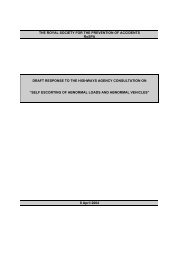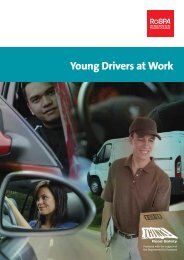RoSPA Drinking and Driving Policy Paper 2007
RoSPA Drinking and Driving Policy Paper 2007
RoSPA Drinking and Driving Policy Paper 2007
Create successful ePaper yourself
Turn your PDF publications into a flip-book with our unique Google optimized e-Paper software.
The Royal Society for the Prevention of Accidents<br />
<strong>Drinking</strong> <strong>and</strong> <strong>Driving</strong> <strong>Policy</strong> <strong>Paper</strong><br />
Updated May <strong>2007</strong><br />
Table 11: Percentage of Fatally Injured Drivers over the legal blood alcohol limit 2<br />
Year 16-19 20-29 30-39 Age 40+<br />
1990 13 22 33 10<br />
1991 11 29 24 13<br />
1992 13 26 18 10<br />
1993 20 28 26 10<br />
1994 16 31 30 11<br />
1995 18 28 26 13<br />
1996 24 38 32 9<br />
1997 25 23 26 12<br />
1998 17 25 24 9<br />
1999 22 31 31 7<br />
2000 20 32 34 12<br />
2001 18 35 25 14<br />
2002 18 31 37 14<br />
2003 18 33 28 12<br />
2004 26 31 32 16<br />
2005* 18 30 34 22<br />
*Provisional data<br />
However, 17-24 year old drivers have the highest number of drink drive accidents per<br />
licence holder. Making allowance for the fact that youngest drivers (17-19) drive<br />
fewer miles each year, then their risk is the highest <strong>and</strong> because they are more likely<br />
to have accidents, the proportion of these which are drink related will be lower.<br />
Enforcing a separate limit for a specific group of drivers would require the Police to be<br />
able to check a driver’s age (or licence status).<br />
Breath alcohol ignition interlock devices (BAIIDs)<br />
Breath alcohol Ignition interlock devices are designed to prevent a car engine from<br />
starting if the person who breaths into the device has been drinking alcohol. They are<br />
used in at least 37 states in America, in one state in Canada <strong>and</strong> have been trialled in<br />
Australia. They are generally applied to repeat offenders, either as an alternative to<br />
disqualification or to follow a period of disqualification, as a type of probation period.<br />
Experience in the USA suggests that they are effective while the order is in force, with<br />
low rates of circumvention, but that re-offending occurs rapidly once the restriction is<br />
removed. Restrictions for one year seem to have no effect on subsequent behaviour;<br />
those for two or more years had a small effect. In Alberta in Canada where the<br />
programme is more closely supervised <strong>and</strong> supplemented by counselling, more longterm<br />
improvements have been experienced. 21<br />
A review 22 of experience with such devices in various countries found that they<br />
reduced recidivism by between 285 to 65% while they are installed. However, once<br />
they are removed from the drivers’ cars, the rate of re-offending increases.<br />
In Britain, a pilot scheme is currently underway with drink drivers who have<br />
volunteered to participate to assess whether the use of alcohol ignition locks<br />
(alcolocks) are effective in discouraging re-offending. The government is giving courts<br />
the power to require drink drive offenders to only drive a vehicle with an alcohol<br />
ignition lock (alcolock) so that if the pilot scheme proves effective, the use of alcolocks<br />
can be quickly introduced as a sentencing option. 23 18
















